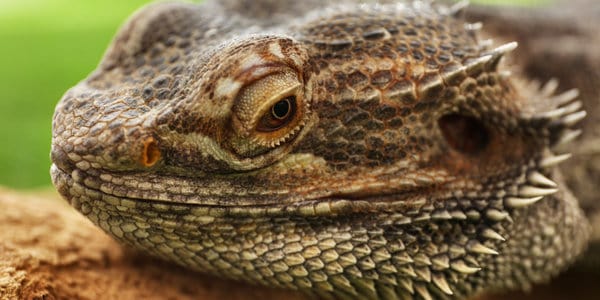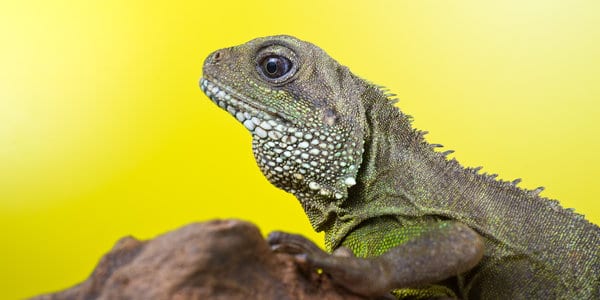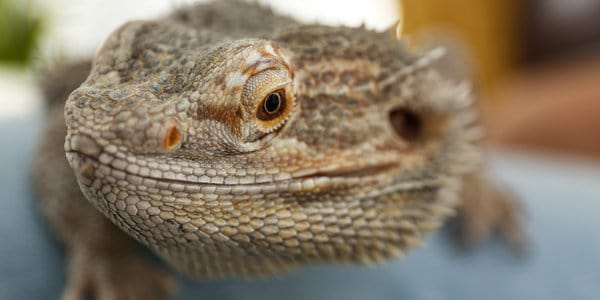Since they were introduced in the United States in the ’90s, bearded dragons have become the most famous exotic pets. As the most popular lizards, beardies have been scrutinized to the core. Several discoveries have been made about their unique and astonishing features.
One thing that most bearded dragon lovers find fascinating about these creatures is the thought that they have a third eye. Although many people don’t believe this is true, experts have proven that the third eye exists on the bearded dragon’s head.
This guide will discuss everything about bearded dragon third eye, including where it’s located, its functions, and how to take care of it.
Is It True That Bearded Dragons Have a Third Eye?
Yes, bearded dragons feature a third eye known as the solar eye, parietal eye, or pineal eye. Beardies join the long list of animals with a third eye, including a few fish, frogs, and skinks.
You would probably not see the third eye when you glance at a bearded dragon. However, when you carefully look at the top of the beardie’s head, you’ll notice a small grey mark or discolored spot. This is the parietal eye (third eye).
This tiny spot might seem useless, but it plays an integral role in thermoregulation and protection against predators.
Furthermore, the solar eye is responsible for various biological functions vital for your bearded dragon’s health.
So, if you thought that bearded dragons having a third eye was a myth, you can now trust that they have it.
The parietal eye sits at the top of the beardie’s head and connects to the pineal gland to form what is known as the pineal complex.
Can Bearded Dragons See from the Parietal Eye?
If the parietal eye is not even visible when you look at the bearded dragon, how do these creatures use this eye to see what’s is around them. Most amphibians and lizards boast the parietal eye.
However, the eye doesn’t have an eyelid or an iris present in the normal eyes. It is covered by a transparent scale and is relatively smaller than the other typical eyes. This explains why the third eye doesn’t look like the two standard normal eyes used for visibility.
The bearded dragon’s third eye lacks the definition and development to perceive actual images. It’s not meant for image perception.
Instead, it’s a rudimentary photo sensory organ that detects shifts in shadows and light, helping bearded dragons know when a predator is approaching from above.
It perceives light differently from ordinary eyes and sends messages to the pineal gland rather than the optical center.
So, bearded dragons can’t see images through the parietal eye but will detect any movement above their heads.
More importantly, the solar eye performs several biological functions pivotal for the bearded dragon’s survival in the natural habitat and captivity.
Most reptile species have a third eye, but it’s not usually visible with naked eyes.

Functions of the Parietal Eye in Bearded Dragons
Now that we understand that the parietal eye in bearded dragons is not used for seeing objects, what purpose does it serve?
Although it doesn’t send signals to the optic center like the ordinary eyes, the parietal eye serves several critical roles integral to the bearded dragon’s survival. These include:
1. The Parietal Eye Regulates Various Biological Processes
Like all animals, bearded dragons rely on various biological processes to live and function normally. These processes are regulated and inhibited by different hormones and chemicals. One of the bearded dragon third eye core functions is to control these biological functions.
The parietal eye links directly to the pineal gland via an opening on the bearded dragon’s skull.
It connects to a part of the brain known as the eye center (where the pineal gland is located), forming the photosensitive system dubbed as pineal complex.
The system is responsible for various biological functions, including hormone production and hormone regulation, and the maintenance of optimal body temperature.
With the help of the parietal eye, the pineal gland works with the epithalamus to release melatonin, a hormone that regulates circadian rhythms.
The third eye detects the diminishing light intensity at the end of the day and sends a message to the pineal gland to release melatonin to induce sleep.
As bright light sets in the morning, bearded dragon third eye signals the pineal gland to inhibit melatonin production, telling the beardie that it’s time to wake up.
Besides hormone regulation, the pineal complex sets the internal clock that helps the bearded dragon determine the time of the day and season.
The system measures the photoperiod of light based on the amount of light it absorbs during the day.
Research has also shown that the parietal eye assists diurnal lizards regulate the amount of sunlight they require, thus preventing hastened metabolic activity that may shorten their life.
Experiments conducted by experts showed that lizards that had their parietal eye removed or sealed could stay in hot temperatures and expose themselves to too much sunlight.
These would lead to faster metabolic activity and a shorter life span. The research also found that lizards missing the parietal eye had difficulties controlling their body temperature.
2. The Parietal Eye Helps in Compass Navigation
As surprising as it seems, the third eye is a compass that helps bearded dragons figure out their way home.
Research by the University of Ferrara, Italy, in 2009 revealed that lizards need the parietal eye for navigation.
First, Italian wall lizards were trained to navigate through mazes in a swimming pool. Then, their parietal eyes were disturbed through painting, alteration of day/night cycles, or removal.
Once the third eye was interfered with and the lizards released into the pool, they could not find their way through the maze.
Only lizards whose parietal eyes were left intact could navigate the entire path without challenges.
Experts deduced that lizards use the third eye to absorb information about the sun’s angle, position, and intensity and use the data to navigate paths that take them home.
3. The Parietal Eye Helps Bearded Dragons Avoid Predators
The bearded dragon’s third eye may not perceive and record clear images, but it detect light and shadow levels changes.
The rudimentary retina, lens, and cornea help the beardie see a sudden change in light intensity and shadow movements over its head.
When the bearded dragon is resting, eating, or surveying the neighborhood with its front eyes, the third eye acts as an alarm system warning the lizards of impending danger.
Once the bearded dragon detects a shadow over its head, it takes a flight or fight response.
However, because the third eye can’t perceive clear images, most dragons keep reacting to everything that casts a shadow over their heads.
The lack of an iris to help focus the object better means that the fight-or-flight reaction takes over.
For this reason, bearded dragons should not be approached from above the head, as they may perceive this as a predatory threat.
The parietal eye is an evolutionary advantage for bearded dragons as it allows them to detect predators before they pounce on them.
Does the Bearded Dragon Third Eye have an Eyelid?
No, bearded dragon’s third eye does not have an eyelid. Instead, it’s covered by a transparent scale that protects the eyeball from external objects. Additionally, the eyeball doesn’t have a membrane to keep it moist.
The transparent scale prevents strange items from the environment, such as dust and sand, from damaging the parietal eye.
However, the scale is still delicate and can be damaged by protruding objects. So, make sure there are no sharp and protruding objects in the bearded dragon’s enclosure, and make sure you don’t touch the third eye region regularly.

Do Bearded Dragons in Captivity Use the Third Eye?
All bearded dragons feature a parietal eye regardless of their habitat. However, since captive-bred beardies are locked up in cages, there is a high probability that they won’t be using their third eye as a navigation compass.
Nonetheless, they will still need to regulate their body temperature and avoid predators even when in captivity.
The pineal eye will measure the heat and light intensity and signal the bearded dragon to get out of the basking area.
Furthermore, the third eye makes sure that the beardie stays alert in case of predation. If you don’t offer ample living conditions and handle a bearded dragon carefully, they might perceive you as a threat.
Things to Do to Avoid Damaging Your Bearded Dragon’s Third Eye
Now that we have seen how essential the Bearded Dragons third eye is, we should strive to create an enclosure that caters to the needs of the bearded dragons.
Although a transparent scale protects bearded dragons third eye on the outside, there are a few things you need to know to care for the bearded dragon’s parietal eye.
1. Switch Off the Lights at Night
The natural day/night cycle is the guiding principle for bearded dragons in the wild. Beardies need a distinguishable day and night cycle to release the appropriate hormones at the right time.
The parietal eye may pick even the soft red glow light that you deem subtle. Even the slightest light can keep your bearded dragon awake all night long.
During the day, ensure that the bearded dragon’s enclosure is well illuminated and dark at night.
2. Avoid Alternating Between Natural and Artificial Light
Although many bearded dragon owners love to take their beardies out of the enclosure to enjoy fresh air, this doesn’t always end well.
Although taking your bearded dragons out to enjoy natural sunlight is a recommendation, it is only good in theory.
Most bearded dragons display a negative response when alternated between natural and artificial light.
Although it is still unclear what causes such a response, experts think it is something to do with bearded dragons third eye.
Because artificial and natural light aren’t similar, bearded dragons in captivity find it hard to adjust to the natural light and vice versa.
If you want to maintain the integrity of the third eye and ensure that your beardies are healthy and happy, try to keep them exclusively in an artificial or natural habitat.
Trying to alternate between the two zones isn’t always exciting for the beardie.
3. Automate the Light Lamps to Maintain the Day/Night Cycle
Automating the lighting system in the bearded dragon enclosure will ensure that you don’t forget to turn off the lights at night and switch them on during the day.
Although automation will cost more upfront, it will ensure that your bearded dragons don’t spend an entire night awake because you forgot to turn off the lights.
Getting adequate light during the day ensures that the third eye gets proper stimulation and that your beardie leads a healthy life.
4. Use UVB Lights Rated for Reptiles and Install them at a Safe Distance.
Don’t install ultraviolet light (UV light) bulbs just for formalities; goo for those recommended for reptiles. Some like mercury vapor bulbs can be too strong for your beardie and can cause some discomfort.
Additionally, the bulbs must be positioned correctly, usually 6 -12 inches from the bearded dragon. If the lamps are installed any lower, they can damage the parietal eye structures beneath the scale.
Are There Other Reptiles with A Third Eye?
Yes, bearded dragons are not the only animals with a third eye. Other creatures such as frogs, skinks, slowworms, a few iguanas, and monitor lizards also boast a parietal eye.
However, for most of these animals, the third is usually for determining the time of day and the season of the year.
The third eye enables them to know when the nights and days are longer. For reptiles, the parietal eye can have other functions such as biological function regulation and compass navigation.

Wrapping It Up
If you are still wondering whether bearded dragons have a third eye, they do. The third eye looks like a grey spot on top of its head between the two ordinary eyes.
Also known as the parietal or the solar eye, the third eye is responsible for some critical functions in the bearded dragon’s body.
First, it helps in various biological processes such as biological clock, thermoregulation and hormone regulation to induce sleep.
It also detect light changes and shadows above the head, enabling the bearded dragon to know when strange features and predators are coming.
In addition, it helps bearded dragon circadian rhythm that they are provided with night and bright white light. Lastly, it acts as a navigational compass, allowing beardies to find their way home.
Considering the usefulness of the parietal eye, pet bearded dragon owners should do everything to make sure that it’s not injured or obstructed.
We hope this guide has provided more profound insights into the bearded dragon’s third eye and answered all your questions.